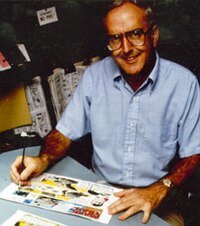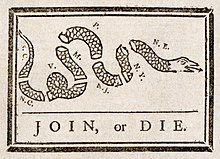Cartoonist
 |
| Comics |
|---|
| Comics studies |
| Methods |
|
| Media formats |
|
| Comics by Country and Culture |
|
| Community |
|
|
|
A cartoonist, also known as a comic strip creator, comic book artist, graphic novel artist,[1] or comic book illustrator, is a visual artist who specializes in drawing cartoons (individual images) or comics (sequential images). Cartoonists include artists who handle all aspects of the work and those who contribute only part of the production. Cartoonists may work in a variety of formats, including booklets, comic strips, comic books, editorial cartoons, graphic novels, manuals, gag cartoons, illustrations, storyboards, posters, shirts, books, advertisements, greeting cards, magazines, newspapers, and video game packaging.
History[]

The English satirist and editorial cartoonist William Hogarth, who emerged in the 18th century, poked fun at contemporary politics and customs; illustrations in such style are often referred to as "Hogarthian".[2] Following the work of Hogarth, political cartoons began to develop in England in the latter part of the 18th century under the direction of its great exponents, James Gillray and Thomas Rowlandson, both from London. Gillray explored the use of the medium for lampooning and caricature, calling the king (George III), prime ministers and generals to account, and has been referred to as the father of the political cartoon.[3]
While never a professional cartoonist, Benjamin Franklin is credited with having the first cartoon published in an American newspaper.[4] In the 19th century, professional cartoonists such as Thomas Nast introduced other familiar American political symbols, such as the Republican elephant.[4]
Comic strips[]
Comic strips received widespread distribution to mainstream newspapers by syndicates,[5]
Calum MacKenzie, in his preface to the exhibition catalog, The Scottish Cartoonists (Glasgow Print Studio Gallery, 1979) defined the selection criteria:
- The difference between a cartoonist and an illustrator was the same as the difference between a comedian and a comedy actor—the former both deliver their own lines and take full responsibility for them, the latter could always hide behind the fact that it was not his entire creation.[6]
Many strips were the work of two people although only one signature was displayed. Shortly after Frank Willard began Moon Mullins in 1923, he hired Ferd Johnson as his assistant. For decades, Johnson received no credit. Willard and Johnson traveled about Florida, Maine, Los Angeles, and Mexico, drawing the strip while living in hotels, apartments and farmhouses. At its peak of popularity during the 1940s and 1950s, the strip ran in 350 newspapers. According to Johnson, he had been doing the strip solo for at least a decade before Willard's death in 1958: "They put my name on it then. I had been doing it about 10 years before that because Willard had heart attacks and strokes and all that stuff. The minute my name went on that thing and his name went off, 25 papers dropped the strip. That shows you that, although I had been doing it ten years, the name means a lot."[7]
See also[]
- Comic book creator
- Penciller
- Editorial cartoonist
- Harvey Award
- List of cartoonists
- List of newspaper comic strips
- Mangaka
- List of manga artists
- The Someday Funnies
- Webcomic
- Female comics creators
- Glossary of comics terminology
- Daily comic strip
- Sunday comics
- Sunday strip
References[]
General references[]
- Hess, Stephen; Northrop, Sandy (2011). American Political Cartoons: The Evolution of a National Identity, 1754-2010. TransactionPublishers. ISBN 978-1-4128-1119-4.
Inline citations[]
- ^ Booker, M. Keith (ed.), Encyclopedia of Comic Books and Graphic Novels, Santa Barbara, California: ABC-CLIO, 2010, p. 573.
- ^ The British Museum. Beer Street, William Hogarth - Fine Art Print Archived 2010-03-03 at the Wayback Machine Retrieved 11 April 2010.
- ^ "Satire, sewers and statesmen: why James Gillray was king of the cartoon". The Guardian. 16 June 2015.
- ^ Jump up to: a b Hess & Northrop 2011, p. 24.
- ^ "The Comics Reporter". Retrieved 17 November 2009.
- ^ MacKenzie, Calum. The Scottish Cartoonists. Glasgow Print Studio Gallery, 1979.
- ^ "Toon Talk : Two Comic-Strip Artists Discuss the Craft They Love". Los Angeles Times. September 28, 1989.
Further reading[]
- Steve Edgell, Tim Pilcher, Brad Brooks, The Complete Cartooning Course: Principles, Practices, Techniques (London: Barron's, 2001).
External links[]
| Look up Cartoonist in Wiktionary, the free dictionary. |
| Wikimedia Commons has media related to Cartoonists. |
Societies and organizations[]
- Professional Cartoonists' Organisation (UK)
- National Cartoonists Society
- Association of American Editorial Cartoonists
- Society of Illustrators
- Society of Children’s Book Writers and Illustrators
- Society of Illustrators of Los Angeles
- The Association of Illustrators
- The Illustrators Partnership of America
- AIIQ - l’Association des Illustrateurs et Illustratrices du Québec
- Colorado Alliance of Illustrators
- Institute For Archaeologists Graphics Archaeology Group
- Guild of Natural Science Illustrators
- Guild of Natural Science Illustrators-Northwest
- Illustrators Australia
- Newsart
- Australian Cartoonists Association 2Xw7QIe
Communities[]
- Cartoonists
- Comic strip cartoonists
- Comics creators
- Visual arts occupations
